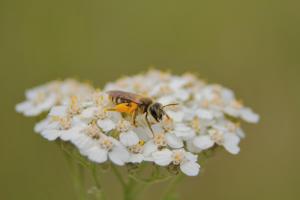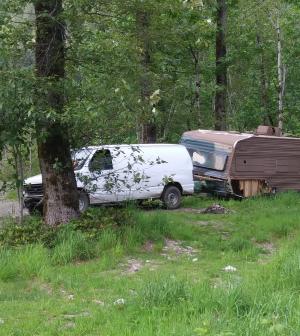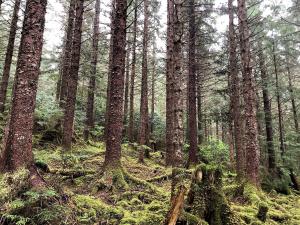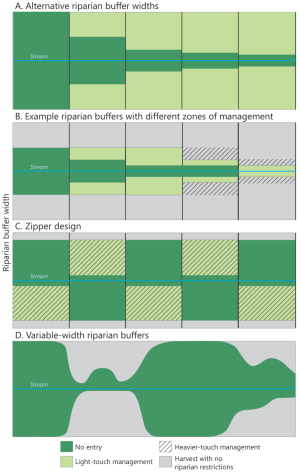Research Highlights
Research Highlights
-
Gordon Grant, a research hydrologist with the Pacific Northwest Research Station, applied a theory he first developed for rivers to a fundamental problem in predicting the impacts of volcanic eruptions: how much lava is flowing out of a volcano over time. His critical flow theory predicts that the wavelengths of standing waves in both water and lava can be used to estimate the depth and velocity of the flow. A team of scientists tested this idea using data from the 2018 Kilauea eruption in Hawaii and found that their estimates were very close to other flow measurements.Year2023Research StationPrincipal Investigator(s): Gordon GrantState(s)OregonHawaii
-
Measuring the potential impact of environmental stressors on natural resources is difficult because it involves complex interactions among environmental factors. To address this challenge, a team of scientists with the Pacific Northwest Research Station and the U.S. Geological Survey used a novel approach to develop a decision-aiding tool that assesses the potential injury to natural resources from the effects of industrial contaminants and pollutants.Year2023Research StationPrincipal Investigator(s): Bruce G. Marcot, Ph.D.State(s)Oregon
-
Rangelands provide habitat for a host of species, including invertebrates like native bees, and forage for livestock. A group of scientists set out to understand how livestock grazing may affect bees in two community types in Oregon. They found that moderate grazing in bunchgrass ecosystems was compatible with bee presence, while grazing in riparian meadows decreased flower, but not bee, abundance and diversity. Their research results can help inform grazing strategies to benefit livestock producers and pollinators.Year2023Research StationPrincipal Investigator(s): Mary M. RowlandState(s)Oregon
-
Scientists documented movements of cougars and male black bears and found that their locations were near elk birth sites more often than expected by chance. Male bears used areas of elk birth sites in a manner that dynamically tracked the seasonal timing of births, suggesting an effort to maximize encounters with newborns.Year2023Research StationPrincipal Investigator(s): Michael Wisdom, Dr.State(s)Oregon
-
Coastal wetlands are highly valued for their role in supporting critical ecological functions and ecosystem services, but these ecosystems are vulnerable to sea-level rise resulting from climate change. To inform coastal wetland management under changing sea levels, scientists with the Pacific Northwest Research Station and the U.S. Geological Survey worked together to develop a new model that predicts the potential impact of ongoing sea-level rise on the resilience of wetlands along the U.S. Pacific coast.Year2023Research StationPrincipal Investigator(s): Bruce G. Marcot, Ph.D.State(s)WashingtonOregonCalifornia
-
Scientists used a natural experiment to assess how the addition of trees to urban neighborhoods affected human mortality in Portland, Oregon. They found that residents in neighborhoods with more newly planted trees experienced lower rates of cardiovascular and nonaccidental mortality.Year2023Research StationPrincipal Investigator(s): Geoffrey Donovan, Jeffrey P. Prestemon, Demetrios Gatziolis, Abigail KaminskiState(s)Oregon
-
Community forests aim to conserve biodiversity and alleviate poverty in countries around the world, but research is needed to determine which models are most effective in different contexts. Susan Charnley, a research social scientist with the USDA Forest Service Pacific Northwest Research Station, explored community forestry projects in Sierra Leone and Guinea. She found that lasting benefits from sustainable livelihood projects can be effective incentives for promoting conservation through community forest models that limit extractive forest uses such as logging, grazing, mining, and hunting.Year2023Research StationPrincipal Investigator(s): Susan Charnley
-
Eric White, a research social scientist with the USDA Forest Service Pacific Northwest Research Station, and cooperators at the University of Georgia researched the status and potential future trends of outdoor recreation in the United States. They found continued strong participation in recreation and evidence that public forests were key providers of recreational opportunities. The researchers projected slight declines in the share of the population engaging in recreation but continued increases in the total number of people recreating outdoors because of population growth.Year2023Research StationPrincipal Investigator(s): Eric M. White
-
Findings from research by the USDA Forest Service Pacific Northwest Research Station and Oregon State University suggest that socioeconomic factors such as income and population density are correlated with human-caused wildfire ignitions. Researchers also found that most human-caused ignitions were linked to escaped fires from recreation or open burning activities. This highlights opportunities to tailor wildfire prevention efforts to better control higher risk activities and reduce accidental ignitions.Year2023Research StationPrincipal Investigator(s): Jeffrey D. Kline, John B. KimState(s)OregonWashington
-
Social scientists with the USDA Forest Service Pacific Northwest Research Station investigated the dynamics of unsheltered homelessness in public natural areas ranging from city parks to national forests in the Seattle metropolitan area. They interviewed professionals who interact with homeless populations to understand perspectives on the dynamics, stressors, and outcomes of public natural area usage by people experiencing homelessness. The team found that several factors, including available ecosystem services and enforcement activities, were seen as driving people’s movement across public natural areas.Year2023Research StationPrincipal Investigator(s): Monika Derrien, Lee K. CervenyState(s)Washington
-
Tree growth is regulated by the changing seasons, but it is not yet well understood how climate change will influence this process as seasonal patterns shift. To address this question, scientists with the Pacific Northwest Research Station measured changes in Douglas-fir diameter growth across 9 environments over 2 years. Results showed that temperatures above 40 °C near the summer solstice in 2021 caused seasonal diameter growth to nearly cease in all sources, with the greatest impact on arid sites. Growth resumed in 2022, and the timing of diameter growth varied with both genetic and site factors.Year2023Research StationPrincipal Investigator(s): Connie Harrington, Richard CronnState(s)OregonWashington
-
Precommercial thinning and tree pruning are frequently used together to improve timber quality and wildlife habitat in even-aged Sitka spruce (Picea sitchensis) and western hemlock (Tsuga heterophylla) stands. Scientists with the Pacific Northwest and Rocky Mountain Research Stations investigated the effects of thinning and pruning in two long-term experiments on the Tongass National Forest, Alaska. They found that pruning can improve log quality for timber applications; however, pruning 50 percent or fewer trees in a stand does not enhance understory plant biomass and deer forage over thinning treatment alone.Year2023Research StationState(s)Alaska
-
In recent years, more frequent, severe fires have burned upland and riparian vegetation across Oregon, subsequently affecting stream and riparian ecosystems. Scientists worked to understand how postfire conditions varied across Oregon watersheds that experienced a range of fire severities. They uncovered new information about the interactions among fire, forest management, riparian conditions, and fresh water.Year2023Research StationPrincipal Investigator(s): Brooke PenalunaState(s)Oregon
-
Stream Best Management Practices guide the management of aquatic and riparian biodiversity in forests. These practices often address habitat concerns through the application of riparian buffers—streamside areas of natural vegetation maintained to protect stream habitats. Rather than universal application of fixed-width buffers, a portfolio of “beyond best management practices” may better address sensitive species like amphibians that require a variety of habitats to survive.Year2023Research StationPrincipal Investigator(s): Deanna ("Dede") H. OlsonState(s)WashingtonOregonCalifornia
-
New research highlights how floods and droughts affect Pacific salmon populations and provides tools to predict locations where impacts may be greatest. This work facilitates collaborative efforts aimed at assessing the resilience of salmon populations that support subsistence fisheries in Gulf of Alaska watersheds.Year2023Research StationPrincipal Investigator(s): J. Ryan BellmoreState(s)Alaska
-
A new, dynamic reality is unfolding as climate change interacts with historical land management, causing changes in riverscape conditions that affect stream habitat and populations of native fishes. In southeast Alaska, a team of scientists with the Pacific Northwest Research Station and Tongass National Forest found that productive locations for coho salmon overlapped with areas of past timber harvest that are likely to be selected again for future harvest.Year2023Research StationPrincipal Investigator(s): Rebecca FlitcroftState(s)Alaska
-
Climate change is resulting in forests with a greater proportion of heat-tolerant tree species, but the factors driving this “thermophilization” process remain unclear. Findings from research by the Pacific Northwest Research Station and the University of California, Berkeley show that recent changes in temperature and hydrology have driven thermophilization in Western U.S. forests at rates roughly 10 times slower than the rate of climate change. These trends suggest that forest tree communities are becoming increasingly mismatched with their environments, potentially threatening ecosystem services provided by these forests.Year2023Research StationPrincipal Investigator(s): Kathryn C. BaerState(s)WashingtonOregonCaliforniaIdahoMinnesotaColoradoNevadaUtahArizonaNew Mexico
-
As dry forests in the Western United States respond to climate change, predicting when and where the ranges of individual tree species will change remains a challenge. To learn more, David Bell, a scientist with the Pacific Northwest Research Station, and his colleagues developed range-wide population models for 3 pinyon pine and 2 juniper tree species to estimate population trends and climate vulnerability of these species. Their findings suggest that the ranges of dry forest species are shifting because of changing recruitment and mortality. Increasing temperatures and drought threaten the long-term viability of many of these species in their current ranges.Year2023Research StationPrincipal Investigator(s): David M. BellState(s)ArizonaNew MexicoColoradoUtahNevadaIdahoMontanaCalifornia
-
Communities near industrial areas can experience heavy metal air pollution that standard air monitoring networks do not detect. Scientists with the Pacific Northwest Research Station and community members in two Seattle neighborhoods adjacent to industrial sites measured and mapped heavy metals in moss samples from urban trees. Local moss had higher levels of toxic metals than moss from other urban areas, leading community members to investigate the issue further.Year2023Research StationPrincipal Investigator(s): Sarah Jovan, Dr, Monika DerrienState(s)Washington
-
Habitable areas for tree species are expected to shift with climate change, but it can be difficult to detect these shifts because of the lack of quality long-term data. To address this challenge, researchers used USDA Forest Service Forest Inventory and Analysis data in the states of California, Oregon, and Washington to examine shifts in the ranges and densities of tree species relative to climate variables. They found that tree species ranges did not change, but their densities did.Year2023Research StationPrincipal Investigator(s): Vicente MonleonState(s)CaliforniaOregonWashington






















